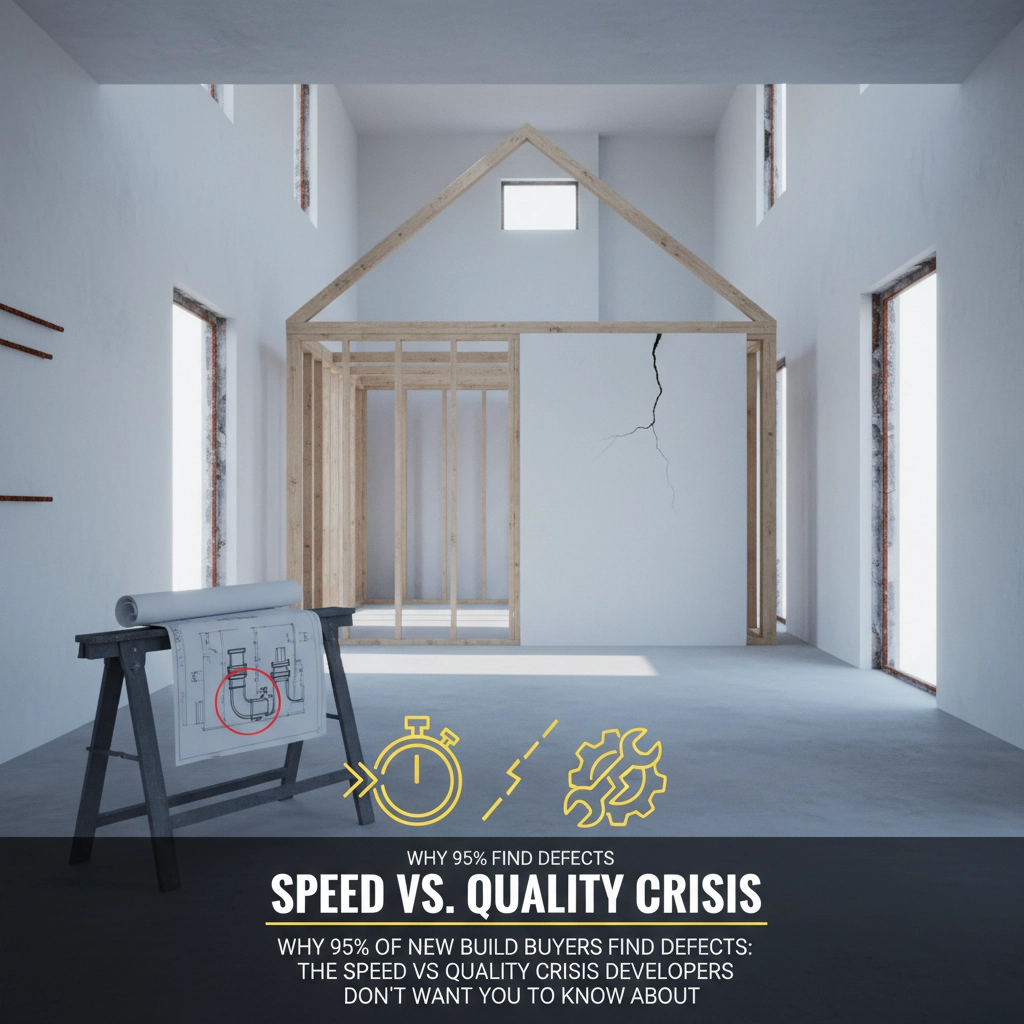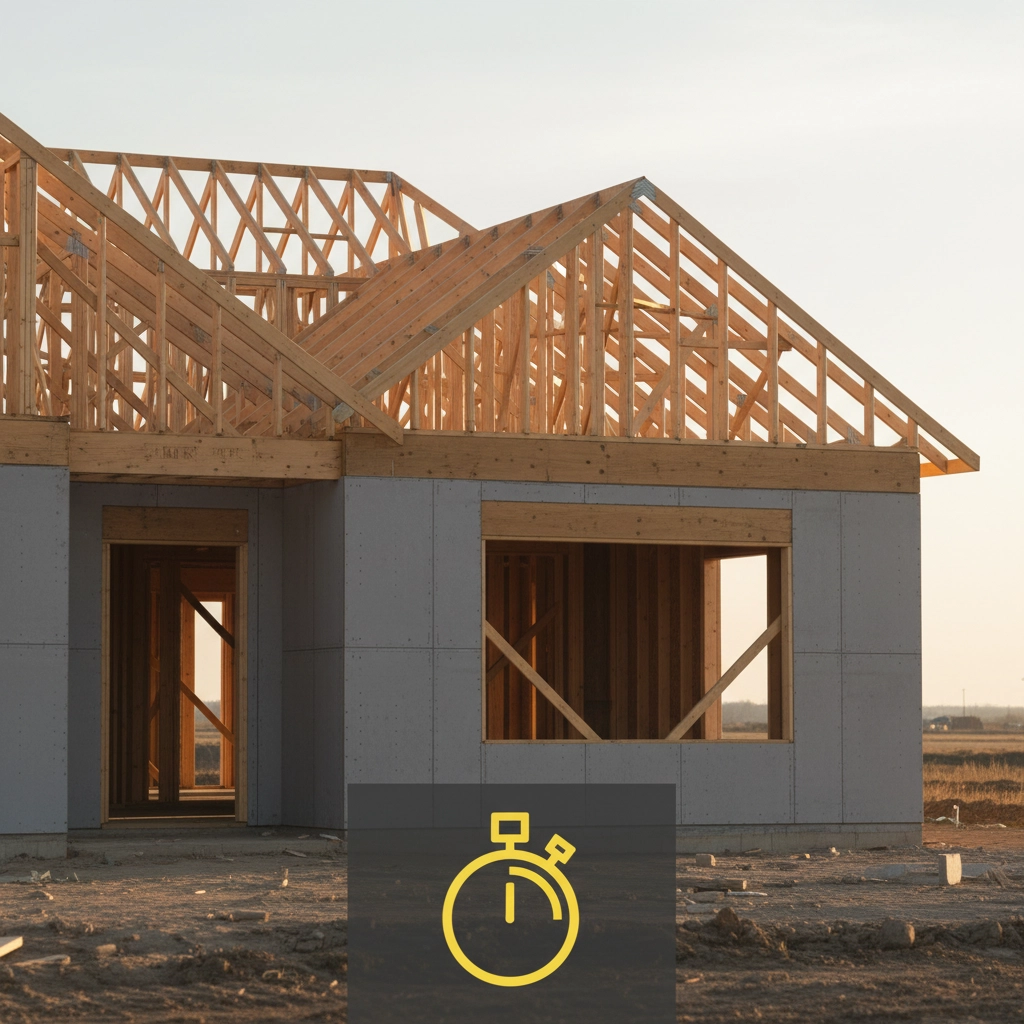Why 95% of New Build Buyers Find Defects: The Speed vs Quality Crisis Developers Don’t Want You to Know About

Here’s a statistic that’ll make you think twice about that shiny new build: 95% of new build homebuyers report defects to their builders after moving in. That’s not a typo: it’s an official figure from the House Builders Federation’s own customer satisfaction survey. If nearly every single new build buyer finds problems with their supposedly “perfect” home, something’s gone seriously wrong with the construction industry.
The uncomfortable truth? Developers are caught in a relentless cycle where speed and profit matter more than the quality of your future home. Let’s pull back the curtain on why this crisis exists and, more importantly, how you can protect yourself.
The Real Reason Behind the Quality Crisis
The construction industry has a dirty secret: profit trumps quality every single time. Research consistently shows that developers prioritize maximizing returns over delivering defect-free homes, creating a race-to-the-bottom mentality that’s become the industry standard.
Think about it: when was the last time you heard a developer boasting about their slow, meticulous construction process? Instead, marketing materials focus on “rapid delivery,” “quick completions,” and “getting you moved in fast.” But here’s what they’re not telling you: this speed comes at the expense of proper craftsmanship.
Modern site managers face impossible pressure to complete homes within just 18 to 24 weeks while managing 30 to 50 properties per year. With timelines like these, attention to detail becomes a luxury the industry can’t afford: or won’t invest in.

The Subcontractor Lottery: Why Quality Craftsmen Are Being Priced Out
Ever wondered why your new build feels like it was put together by different people with varying skill levels? That’s because it probably was. The subcontractor selection process has devolved into a pure cost-cutting exercise where “everything comes down to price.”
Here’s how it works: developers pressure subcontractors to slash their quotes during the bidding process. The result? Either quality craftsmen get priced out entirely, or they’re forced to cut corners just to win contracts. Meanwhile, less experienced workers who’ll accept lower wages fill the gap, often lacking the skills needed for quality construction.
The skills shortage in construction makes this worse. With experienced tradespeople becoming scarce, developers rely on whoever’s available and affordable. Combine inexperienced workers with inexperienced site management, and you’ve got a recipe for the defect epidemic we’re seeing today.
Don’t leave your biggest investment to chance. At Snagit Ltd, our professional snagging surveys catch these subcontractor shortcuts before you sign on the dotted line.
Planning Delays: The Hidden Catalyst for Poor Quality
Planning delays create a devastating domino effect throughout the construction process. When developers finally receive planning approval after lengthy bureaucratic delays, they implement unrealistic build programs to make up for lost time.
This creates enormous pressure throughout the supply chain. Subcontractors who might normally take proper care with their work find themselves racing against impossible deadlines. Quality control measures get compressed or skipped entirely. The result? Your new home becomes a victim of the planning system’s inefficiencies.
What 95% of Defects Actually Look Like
Let’s talk about what you’re actually likely to find in your new build. Professional snagging companies routinely discover 40 to 180 defects per property, depending on size and build quality. These aren’t just cosmetic issues: we’re talking about serious problems that affect your safety and wallet.
Common defects include:
- Electrical hazards that pose fire risks
- Structural problems requiring engineering reviews
- Gas leaks and explosion hazards
- Water ingress causing immediate mold growth
- Missing insulation and vapor barriers
- Improperly fitted windows and doors
- Heating system failures
- Plumbing defects leading to flooding

Some homes develop black mold within months of construction, particularly when built using particle board or OSB that gets soaked during rainy weather and then covered up. We’ve seen cases where moldy lumber is used throughout entire houses: problems that should never make it past basic quality control.
The Inspection Gap: Why Official Checks Fail
You might think organizations like NHBC (National House-Building Council) would catch these problems before you move in. Unfortunately, the pressure to meet completion deadlines means official inspections often become box-ticking exercises rather than thorough quality checks.
Site teams and warranty providers routinely fail to identify defects that professional snagging companies find immediately. Why? Because they’re part of the same system that prioritizes speed over quality. Their job is to get homes completed and sold, not to slow down the process with detailed quality assessments.
This is exactly why the professional snagging industry has emerged over the past decade. If builders were delivering quality homes, independent snagging companies wouldn’t need to exist. Our growth is a direct response to the industry’s quality crisis.
The Marketing Smokescreen
Despite overwhelming evidence of quality decline, developers continue promoting misleading satisfaction statistics. The House Builders Federation claims 91% of new build homeowners would recommend their experience to friends, but these surveys are weighted in favor of builders competing for five-star ratings.
Here’s what these statistics don’t tell you:
- They’re conducted before serious defects become apparent
- They focus on customer service, not build quality
- They exclude buyers who’ve had the worst experiences
- They don’t account for the stress of dealing with multiple defects
The reality is that finding defects in your new build has become so common that it’s considered normal rather than exceptional. This represents a fundamental shift where new construction homes are essentially guaranteed fixer-uppers.

Why Professional Snagging Is Now Essential
With 95% of buyers finding defects, professional snagging isn’t a luxury: it’s a necessity. Here’s why getting an independent survey from Snagit Ltd makes financial sense:
Before you complete purchase: We identify serious defects while you still have leverage with the developer. Once you’ve signed and moved in, getting problems fixed becomes much more difficult and expensive.
Comprehensive documentation: Our detailed reports with photographic evidence ensure nothing gets overlooked or disputed. We know exactly what to look for and how to present findings that developers can’t ignore.
Safety first: We catch dangerous defects like electrical hazards, gas leaks, and structural problems that could put your family at risk. Some issues we identify require immediate attention from qualified specialists.
Long-term savings: Identifying defects before completion saves thousands in repair costs later. It’s much cheaper to have problems fixed during construction than after you’ve moved in and damaged finishes need replacing.
Don’t Become Part of the 95% Statistic
The speed vs. quality crisis in new build construction isn’t going away anytime soon. Developers have created a system where profit margins matter more than your satisfaction, and planning delays continue creating impossible timelines for quality construction.
But you don’t have to become another statistic. Professional snagging surveys from Snagit Ltd give you the independent expertise needed to identify problems before they become your problems.
Our experienced surveyors know exactly what to look for because we’ve seen the same defects across thousands of properties. We understand the shortcuts developers take and the problems subcontractors create when working under impossible pressure.
Ready to protect your investment? Contact Snagit Ltd today for a comprehensive new build snagging survey. Don’t let speed and profit come at the expense of your dream home’s quality.
The construction industry’s quality crisis is real, documented, and affecting 95% of new build buyers. But with the right professional support, you can be part of the 5% who move into a home that actually meets the standards you paid for.
